Watch Phones and Smartwatches
– Will someone please design one that doesn't suck?
While browsing through eBay back in 2008, by accident I discovered a peculiar device: it looked like a wristwatch but it was a fully functional wearable cellular phone. I bought one as an experiment, but it proved surprisingly practical. My main phone has been a watch phone ever since. However, there is still a lot of room for improvement. This article explains why and how.
A much shorter summary of this article is available.
In a Nutshell
This is a lengthy article. Therefore, first a summary of the most important points.
I do not believe in the concept of the ‘smartwatch’ that companies are currently trying to sell, being a wearable extra display for a smartphone. Why use the smartwatch if one is required to carry the more handy smartphone anyway? The only device that makes sense is a ‘watch phone’ that is fully autonomous, can make calls and go online all on its own.
People currently associate watch phones with awkwardly talking to their wrist. This cliché must be broken for watch phones to become successful. A watch phone can only be practical as a telephone if it is detachable from its wrist band in a split second, such that it can be held like a true handset. It can only be practical as a watch if it shows the time continuously without requiring interaction. It must be water-resistant and have at least a full week of battery autonomy.
Anyone who aspires to manufacture a watch phone must remember to keep it simple. I rather have a small practical watch phone with a small set of features that all work perfectly, than a huge clunky device with a gazillion features none of which work satisfactorily. When marketing your product, remember that the stubborn ‘Knight Rider’ cliché must be beaten: emphasize the detachability.
If you are a consumer and are interested in watch phones, my advice at the time of this writing (May 2014) is to wait, because all models currently available are likely to be frustrating in some way. Some companies like Neptune, WiMe, and HeadWatch are coming close to manufacturing a usable watch phone, but they are not there yet. Some Chinese watch phones are pretty OK, but the quality level even within the same product line is so variable that buying one is a gamble.
A Short History of Watch Phones
Back in the time of old James Bond films and the Knight Rider TV series, a watch with built-in voice communication facilities was pure science fiction. However, the unstoppable drive for technological miniaturisation gradually brought us closer to a wristwatch combined with a cell phone. Around the turn of the 21st century, the first watch phones became reality.
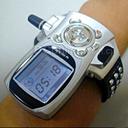
It seems the whole watch phone craze started out around 2003 with a model created by CECT, called the F88 or Telson TWC 1150. It was more like a small regular cell phone turned 90° to the left and equipped with a wrist band. It was large, unwieldy and ugly, but technically a watch phone. There was an even older model by Samsung, the SPH-WP10 from 1999, but it is hard to find any useful information about it. 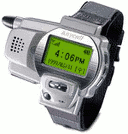 It appears to have been produced in very limited numbers. What I can find looks similar to the F88: something like a head-on collision between an old-style cell phone and a clunky watch. In Japan, other and arguably more practical designs like the Wristomo appeared, which was like a wristband that could be folded open to become a regular phone. The problem with Japanese phones is of course that they are incompatible with the GSM network, therefore they could never become popular outside their home country.
It appears to have been produced in very limited numbers. What I can find looks similar to the F88: something like a head-on collision between an old-style cell phone and a clunky watch. In Japan, other and arguably more practical designs like the Wristomo appeared, which was like a wristband that could be folded open to become a regular phone. The problem with Japanese phones is of course that they are incompatible with the GSM network, therefore they could never become popular outside their home country.

A few years later, around 2007 Hyundai released what I consider the first real widely available watch phone: the W100. It was much smaller than the F88 and much more practical, especially because it could be detached from its wristband and used as a regular tiny cell phone. It was soon followed by Chinese clones and a whole string of other models. What most of these newer models lacked though, was the possibility to quickly detach the phone from the wrist. Apparently the manufacturers hoped either that speakerphone mode would suffice, or users would be willing to hold their arm in uncomfortable positions, or they would not mind using a headset of some kind. One particular model even had a built-in bluetooth earpiece. It seems they were wrong though, because watch phones still did not become a major hit.
After a while two major brands, LG and Samsung, announced each that they would produce their own watch phone. Expectations were high: everyone assumed that they would do better than the Chinese models which all proved to be very similar hardware and firmware inside different housings. Unfortunately, both the LG GD910 and Samsung S9110 were a flop when they hit the market around September 2009. Apparently the world was not ready for watch phones. Moreover, the two devices lacked in certain features that the much cheaper Chinese phones already had for years. What may have been the largest put-off for the general public however, is the fact that these two models again failed to be convenient telephones like the Wristomo or W100. No matter how cool Knight Rider was, nobody wanted to appear to be talking to KITT.
Recently, a new wristwatch-like device has shown up: the so-called smartwatch. The difference with a watch phone is that a smartwatch is only an extension of a smartphone: it needs a wireless connection to a nearby smartphone to go online. It may also use this connection to serve as a wireless loudspeaker and microphone. Some notable models are the Pebble and I'm Watch. There are rumours about Apple making a similar device as well.
Why ‘Smartwatches’ Do Not Make Sense
As described above, I consider a smartwatch the kind of device that is only a wireless additional small screen for a smartphone, with perhaps also a microphone and loudspeaker. It needs a smartphone in its direct neighbourhood to offer any online functionality. What I call a watch phone on the other hand is a standalone device that can make calls and connect to the internet all by its own. These are the definitions I use, be aware that other people may intermingle them. Watch phones are also often called “standalone smartwatches.”
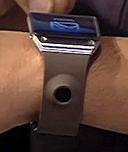
For me and most other watch phone aficionados, the whole point of a watch phone is to have one small device that offers the convenience a watch, combined with the functionality of a cell phone. A watch phone means freedom. It has taken an awful lot of time until I caught on with the cell phone craze, and even despite the fact that phones had gotten pretty small by that time, I still disliked having to carry around that chunk of plastic. I started out with a pretty expensive Ericsson T39m, not the kind of thing you'd like to drop on hard concrete or accidentally dunk in a toilet bowl. And of course, the times when I had forgotten to carry the phone along were also the times when someone tried to call me with something urgent. Ironically, the evolution towards smaller phones has recently been shifted in reverse due to a drive towards larger screens (“phablets”). Gotta love the Western world's obsession with increasing figures.
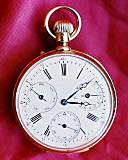
The whole point of a watch phone is to be able to leave the brick at home and still be connected. For many people on the other hand, a cell/smartphone is a sufficient reason not to wear a watch. They seem to find wristwatches uncomfortable to wear, or maybe associate them with a bygone era and therefore gladly lug around a chunk of metal, plastic and fragile glass just to feel modern, whatever that would mean. Most ironical is that using a smartphone as a timepiece is very similar to using a pocket watch, something that was fashionable in long gone times and made obsolete by guess what—wristwatches.
These two facts combined, my conclusion is that ‘smartwatches’ make no sense at all: they do not appeal to the group of people who see a watch phone as a replacement for a larger phone, because the smartwatch still requires to carry that larger phone. Nor do they appeal to the group of people who consider their (smart)phone a reason not to wear a watch. Neither group will want to both carry a phone and wear a watch. Making calls, texting and browsing is inevitably less convenient on a watch-like device than on a regular phone. If the phone must be carried at all times anyway, why not use it all the time?
To me, a wearable communication device only makes sense if it can go online all by its own. Only then it may win over some of the people who had ditched their watch for a phone. There are some people however who do seem to like the smartwatch idea and (gasp!) dislike the idea of a watch phone. What makes therefore the most sense overall, is a device that can appeal to all the kinds of people mentioned above. It should be a hybrid between a watch phone and a smartwatch: fully autonomous, but also usable as a proxy to another phone. If the user does not care about the phone functionality, they can simply use the device without a SIM card.
Historically, humans seem to have an unrealistic tendency to look for a single solution (a panacea) to solve all known problems. This could explain why I have seen people react to the idea of watch phones as if those are a threat to smartphones and tablets. There is this completely unfounded fear that if watch phones would become popular, everyone would be forced to work on tiny screens. Is it so difficult to accept the existence of multiple devices that are best suited for specific use cases? Why not have both a tablet/smartphone and a watch phone with complementary qualities they each excel at, instead of one jack-of-all-trades device that is mediocre at everything?
Wearable tech like watch phones will only gain popularity beyond the current group of hardcore nerds (like me) if it can coexist and cooperate with other communication devices like smartphones, instead of trying to replace them. Suppose I am outside jogging or walking the dog while only wearing my watch phone and I receive an important call. I then could go back home while already answering the call, and seamlessly transfer the call to my smartphone to be be able to talk more conveniently. Or, someone calls me on my smartphone and I badly need to do something that really requires me to use both hands and move around a lot. I can then transfer the call to the watch in speakerphone mode, and be free to go anywhere I want.
My Ideal Watch Phone: Features
It is obvious that simply putting cell phone functionality inside a wristwatch-shaped device does not make a successful product, otherwise watch phones would have caught on by now beyond the small group of nerds like me who really believe in the concept and are willing to ignore the flaws of all current implementations. I am certain the watch phone market could grow considerably if someone would manufacture a model that fixes all current shortcomings.
Because it is a Watch Phone, it must be able to do what its name says: it must work well both as a watch and as a phone. It should also offer internet access like any other smartphone. All the rest is of secondary importance. What follows is a list of properties, most important first, that I believe are essential to make a watch phone successful. Properties in a lighter shade are not essential but still nice to have, they could discern between a basic and premium model.
- The phone must be quickly detachable from its strap. Because I find this such an essential feature, I have written an entire paragraph about it.
- To be a useful watch, it must show time (and optionally date) continuously in stand-by, without the need to push a button or touch the screen. It is a challenge to implement this in an energy-efficient way, but there must be an innovative solution (e.g. the GEAK II uses an e-ink display underneath an LCD). Time must be visible in the interface at all times except when viewing images or videos full-screen. Time must be synchronised from the cell phone network, internet, or GPS if available.
- To be a useful phone, it must have a microphone and loudspeaker built-in with perfect audio quality (no echo, no distortion). It must work well in both hands-free mode and when holding the phone close to one's ear. It must have excellent quad-band signal reception. It has Bluetooth that works with any handsfree kit or headset, which can be enabled and switched to in the middle of a call. A standard TRRS jack for a wired headset would be nice. The phone should be able to detect whether it is used in hands-free mode or held near someone's ear, and automatically adjust loudspeaker volume accordingly.
- To be a useful internet device, it must have at least a basic internet browser that is quick and easy to use. The argument that the screen on devices like these is too small for a browser, is bogus. Although browsing full websites will be unpractical, tons of useful customised webpages could be displayed. A favourite bookmarked page must be visible on the screen within seven seconds of thinking about it. It must have at least 3G and Wi-Fi for data connections. It must be possible to configure the data account for any kind of network, manually if need be. 4G (LTE) would be nice. It must be possible to quickly turn off any power-hungry function (including Bluetooth) without having to dig through many menus.
- Reasonably priced. This thing will not stand a chance if it costs more than a larger device that allows more convenient voice calls and internet access. I am willing to spend up to US$250 on a ‘basic’ model, and $400 on a ‘premium’ model, but I would rather see prices between $150 and $300.
- Thin, fashionable and elegant, yet sturdy. At most 12mm thick, preferably less than 10mm. Not an ugly thick lump that makes the wearer look like a dork. See sketches for other maximum dimensions.
- The entire top surface of the device must be one big high-resolution scratch-resistant touch-screen with no wasteful borders, readable in direct sunlight. The display must be either extremely durable or have a small bezel around it to protect it from damage. The backlight should adapt automatically to ambient light level. A colour display would be nice.
- Long battery life: at least five days of light usage, a full week or more would be great. Even with heavy usage it must be possible to get from early morning to late evening without recharging. Charging and data transfer must be possible using a standard micro-USB cable. Wireless (inductive) charging would be nice.
- At least water resistant. It must survive a short full submersion, or a long bike ride through a rain shower. IP67 waterproof if possible.
- All basic functions can be controlled without a stylus: calling, browsing addresses and entering PIN code must be easy to do with fingers only. I do not care what technology the touch screen uses, if only it is responsive, accurate, and durable. An optional stylus-enabled mode for entering text could be offered if it enhances typing speed and convenience.
- Multiple input methods that cater for different situations or preferences: fast and responsive handwriting recognition and classic multi-tap T9 keyboard for situations where using a stylus is inconvenient. For people with sharp eyes, a tiny full keyboard that can be operated with a stylus or sharp fingernail. A smart keyboard that can guess what was typed despite hitting the wrong keys. All these methods must work extremely snappy and smoothly to compensate for the inevitable inconvenience of entering text on such a small device. All symbols present on a full-size keyboard can be entered. Any language is supported, or language packs can be installed. All methods provide predictive completion that adapts to most commonly used words.
- Large internal storage and/or microSD card slot. No arbitrary storage limits on address book or messages (SMS, mail).
- Organiser, address book, notes, etc. can be synced from/to a cloud service.
- A camera. See sketches for camera placement. I do not really care about the resolution, if only photos are perfectly sharp up to a macro distance of about 5cm.
- Allows installing apps with no restrictions except hardware limitations.
- Backed by a company that will quickly fix any reported bugs, or a completely open source platform backed by a sizable community.
- Built-in GPS linked to a maps application with sat-nav.
Anyone who aspires to design a watch phone should realise that both technological and practical constraints are very stringent. Do not succumb to the temptation of squeezing in as much technology as possible. One of the reasons why products like iPod and iPhone conquered markets that had existed for many years, is that they focused on what matters only and discarded everything else. They pushed away existing over-engineered products that failed to get core features right due to clutter of redundant functionality. When I look at things like the EmoPulse concept, it is obvious that not everyone has learnt from this historical lesson.
Talking about technological constraints, my years of experience with watch phones have taught me that antenna placement is very important, and tricky. The antennae must be placed as far as possible from the wearer's arm because the human body is a very poor medium for radio waves. This again speaks in favour of detachability: when the phone is removed from the wristband, the arm no longer acts as a signal absorber. Also, the microphone wires must not be anywhere near the GSM antenna, or the person at the other side will hear nothing but BZZZZZZZTTT when the cell signal is weak and the phone boosts its antenna to maximum power.
I do not necessarily want all watch phones to run Android although it would be a logical choice. It would automatically fulfil some of my requirements and would finally get rid of the frustrating variability in features and flaws that stem from incompetent manufacturers trying to rig up their own interface. I am sure it is possible to build a decent interface with the MTK Nucleus OS that is the base of most current watch phones, but it will require a lot more professionalism than evident from current Chinese models.
A Watch Phone Must Be Detachable
It is difficult to stress how important this feature is, so I moved it to its very own paragraph for emphasis. It must be possible to remove the phone from the wrist within two seconds flat and hold it like a regular phone. The general public still has a firm belief that a watch phone can only be used through uncomfortably talking to one's own wrist, possibly looking like an idiot in the process. I have been using watch phones since 2008. Here is something that has struck me:

During all those years, Every Single Person to whom I told that my watch is also a telephone, instantly and mocklingly made the same remark: if you make a call, do you have to hold your arm up like this?
and then they would make the same move as when Michael talked to KITT in Knight Rider. This should be a reality check for anyone who wishes to design and manufacture a watch phone: As long as people believe that a watch phone is permanently strapped to one's wrist, the concept shall not catch on. Nobody wants to be forced to use speakerphone mode which would make the entire call audible to everyone in the room. Nobody wants to be forced to carry a headset. And nobody wants to look like a character from an 80s TV show — no matter how cool it was — and risk a cramp in their arm during a lengthy call. All these issues are avoided by allowing the watch phone to be held like any regular cell phone.
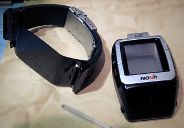
Ideally the phone must be detachable from the strap like the Nova N800. Its detachment mechanism only added one millimetre to the total thickness, which I find totally acceptable. Look below for a sketch of how this works. An easy to open strap is an alternative, albeit less desirable. Note to manufacturers: a tang buckle strap is not easy to open. If you badly want to use a tang buckle, you must make the phone detachable from its strap. If it is not detachable, use a folding clasp.
Next to this practicality aspect, there is also the simple fact that when a phone is strapped to one's arm, signal reception is bound to be worse. This is inevitable, as a human arm is large enough to interfere with the wavelengths of GSM signals. Even if you do not believe the physics behind this, you can believe my more than six years of experience with watch phones that confirms it. Taking the phone off the wrist can make the difference between losing a call and being able to answer it.
Really, I suppose one needs to have hands-on experience to understand how essential detachability is. When I received a phone call on my detachable Nova N800, I had a feeling of oh yeah.
With the subsequent non-detachable models, an incoming phone call gave me a feeling of oh no.
Enough said.
My Ideal Watch Phone: Sketches
Because “an image says more than a thousand words”, here are some sketches I created of a model that I would gladly buy if someone could build it:
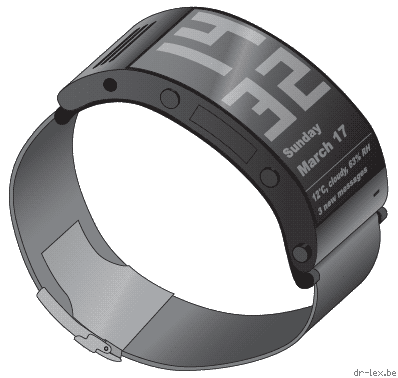
It should not be surprising that this looks much like a cross-breed between all watch phones I had hands-on experience with: the detachable system from the Nova N800 with a mix between the design of the S9110 and TW810. Mind that the display is actually curved: with an e-ink or OLED display this should be possible. The curve should match the average human wrist. Although I have drawn the design with sharp edges, the actual product could have rounded edges to make it more comfortable to wear.

The above image shows a top view with the location of all important parts. The strap should be a standard size, not something proprietary.
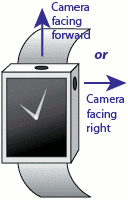
Camera placement is somewhat tricky. Design-wise, right-side is preferable: on this kind of curved design, top-side placement would require disrupting the smooth body shape, e.g. adding an ugly ‘bulge’ as on the Nova N800 or S9110. On the other hand, right-side placement would force people to wear the watch on their left arm. Moreover, the viewscreen must be rotated accordingly while taking photos, otherwise it is awkward to frame something because movements are rotated 90° relative to what is seen on the screen. Then again, if the phone would be detachable, people would never bother trying to take pictures with the device on their arm: they would detach it. When detached, landscape-mode display actually is a plus.
For anyone not familiar with the W100 or N800, this is how the detaching mechanism could work:
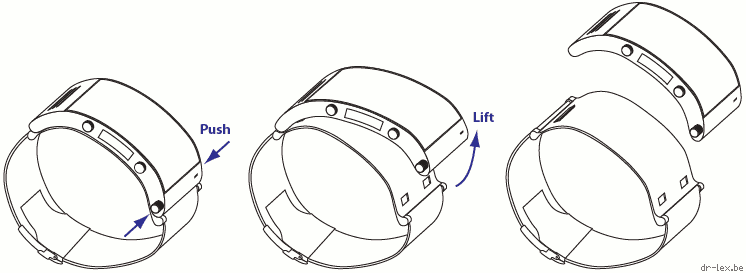
Pushing two buttons at each side releases two clutches at the bottom. Pulling the phone upwards causes it to hinge around the top and subsequently detach. There you have it, from wristwatch to handheld phone in less than two seconds. No awkward “I am testing deodorant” poses, no stupid headsets, no shouting to your wrist. The detachment mechanism must obviously be reliable such that there is no risk that the phone will ever detach spontaneously. Even if one of the two release buttons is accidentally pressed, there must be no risk that the phone detaches. Of course, any other design that meets the same demands is OK. For instance, simply sticking the phone to the band with high-quality Velcro® might also work fine.
Given that it will be necessarily small and light anyhow, a built-in foldable clip could allow to hook the detached phone to the user's ear like a headset. This was the main idea of the proposed HeadWatch (which unfortunately is only a smartwatch, not a watch phone). (Website is now defunct, used to be headwatch.com.)
Considering dimensions, it must not be any larger than indicated in the following image. For a device that is not curved, maximum height is reduced to 50mm. The maximum thickness includes the strap ‘base’ for detachable models. 12mm may seem challenging, but is actually plenty when considering that a sixth generation iPod Nano (without clip) is less than 6mm thick. Obviously, I would greatly appreciate a design even less than 12mm thick.
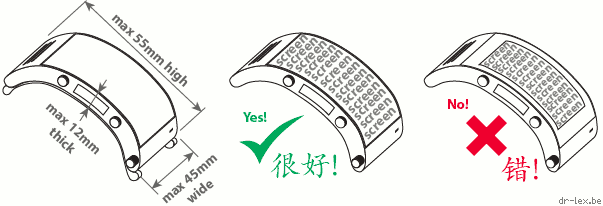
This image also stresses that the screen should cover the entire top and is not surrounded by a large border like on all current watch phones. If the technology to do this is not yet available, I will settle for the design in the rightmost image in exchange for a drop in my maximum price.
As with all tiny electronic devices, the most challenging part will probably be the battery. I wouldn't mind if the battery is not easily swappable, if only it lasts long and can be replaced by the customer. The battery will be under quite a bit of stress, it will wear out quickly, and replacing an entire device just because one rather inexpensive component has worn out, is ridiculous.
It will take some cutting-edge technology to build this thing: a curved borderless touchscreen, and a thin battery with enormous capacity and of course zero risk of exploding on someone's wrist. Anyone who believes they're up to the challenge, go ahead! Of course I will happily settle for any reasonable approximation of this design. What matters the most to me if anyone designs a watch phone according to these specs, is that it behaves according to the specs, not necessarily that it looks exactly like my sketches. For all I care it may look totally different, if only it is detachable, small, … etc. Feel free to build something that looks exactly like these sketches if you think they are good. I will not ask royalties (one free copy of the final product would be appreciated though). Therefore I release this design under the following license:
This work is licensed under a Creative Commons Attribution 3.0 Unported License.
Chinese Watch Phone Roulette
This section discusses the state of Chinese watch phones at the end of the year 2013. It is possible and quite likely that the situation has since improved, although I am certain that the kind of cheap Chinese knockoffs that might even make bad copies of products from other Chinese companies, will not vanish in the near future. It will probably also take a while before the Chinese realise that skimping on quality control could have a severe negative impact in the long run.
Due to lack of anything that comes close to my ideal watch phone, the most reasonable approximations are to be found in China. The price per feature for the few Big Name Company products is way too high. What bothers me most about Chinese watch phones is that most of them are variations on the same old theme. Not much has improved since my old Nova N800. If any of you Chinese manufacturers read this: please stop churning out the same old Mediatek MT62xx hardware and software in different fancy shells. I want to see real innovation not only on the design front but especially under the hood. It is time for a radical upgrade of the old Nucleus-based MTK OS that keeps on being regurgitated in these phones. It is good to see companies like Burg (unfortunately apparently defunct now) and sWaP who obviously do more design and quality control on their interface, but they too seem to be stuck with the same platform.
Aside from the outdated technology, there are three major problems with all phones that originate from the cesspool that is Chinese corporate culture, or the Wild East as I call it.
The first problem is that there is no support at all. In very rare cases you might be able to buy close to the source, and have the phone configured to your likings, and maybe get a software update that needs to be applied in a very cumbersome way. In most cases however, you will buy from people who do not know whether the list of features on their sales pages is remotely correct. At best you may be able to send the phone back if something is wrong, and get a refund or a replacement with a high likelihood of exhibiting the same or different flaws (thanks to problem number two). By the way, forget about software updates: it is a non-existent concept in the Chinese phone world.
Problem number two is that the Chinese idea of quality control must boil down to something like: “turn it on, push a few buttons, and if this succeeds, slap a ‘PASS’ sticker on it.” I do not think the software is tested aside from a cursory skimming through the menus. As for the hardware, I wonder if certain Chinese companies have any decent in-house knowledge about electronics design at all. Their products often violate principles I learnt about in my first years as an engineering bachelor. Someone very skilled with electronics and software may find limited ways around this lack of quality assurance. They may be able to fix certain hardware flaws, or extract the firmware from the phone and make small corrections or replace it with another firmware obtained in far away corners of the internet. The Mediatek platform these phones are based on is completely closed. Unless the phone supports Java, it is impossible to install or replace apps.
The third problem is that when buying a Chinese watch phone, there is no way of knowing what you will actually get. You could buy three models of the same name, that look the same from the outside, with entirely different hardware and software inside. My best guess as to why this happens is that there is no such thing as copyright in China and companies clone designs at will. This can vary anywhere between making an identical clone, and starting entirely from scratch. What is always copied with near perfection however, is the outside design and packaging. It is nearly impossible to see the differences without using the phone or disassembling it.

Thanks to these three issues, buying a Chinese watch phone is like playing roulette. I kid you not, the chance that you'll receive a perfect near-bug-free watch phone may be about as large as winning a single roulette game. All you can do is pray that you won't receive one with a deal-breaking defect, because nobody will repair it for you. Even simply getting your money back may be an ordeal because a lot of shops, even ones that appear to be based in your own country, are in practice operating from China. Chinese traders do have honour though, and will often jump through hoops to keep their customers satisfied, something that cannot be said from some local importers in Europe or the USA.
There, if you wanted to know why Chinese products like these are priced so reasonably, well now you know. Quality control and support are costly, and cutting down on them allows cutting down the price. In a certain sense, what you buy is simply an unfinished product. The bottom line is that at this time I strongly recommend the average public not to buy a Chinese watch phone, because there is a huge risk of being disappointed and frustrated. There are many things that can go wrong. It has become obvious that I have been very lucky with my first two models. The three ones I subsequently ordered all had major bugs that made them between totally useless and barely usable. Only if you are really passionate about watch phones and are either extremely patient or geeky and technically proficient, I could say: it is worth a try. Otherwise, I would wait until a company that knows what ‘quality’ means, gets their act together and builds something like my proposal.
Some Existing Models and Their Pluses and Minuses
One thing I can say in advance of existing models is that they all waste space around their display that could have been used to provide a larger usable surface, if the technology existed. Making these inherently small devices larger would be ridiculous, therefore it is paramount to maximise usable display area. The absolute maximum is that each square millimetre of the top surface is covered by pixels, and this is what manufacturers must strive for.
Of all pre-Android Chinese watch phones I can also tell in advance that they all suck at internet access. Only some exotic and massive brick-like models offer anything above prehistoric GPRS. Even webpages specifically reformatted for the tiny screen load slowly. A simple upgrade to EDGE would already make browsing much more palatable. The built-in browser is primitive, comparable to Netscape 1.0 but with decent CSS support, and a random grab of bugs. Some recent models try to be fancy by dropping all manual configuration and only offering an ‘automatic’ configuration of APN etc, that probably only works with a few Chinese operators. Those phones are like cars where the manufacturer left out the fuel line, hoping that gas will get into the engine by pure magic. If any of you 中国人 read this, please allow manual configuration or I will never ever buy any of your stuff again. If it seems like I've had a frustrating experience with these phones, it is because I have.
Mind that Chinese models are often sold under different names. The names I use here are the most common ones. As for most of the countless models I did not mention here, I can give a rather short summary: they are either very similar to the ones mentioned here, ugly, huge, unpractical, poorly built, or any combination of the above.
There seems to be a recurring theme in the Chinese watch phone market: when a new model improves upon certain features, it gets worse in other features. For some reason the total degree of ‘suckiness’ must remain the same. I dub this the Chinese watch phone law of conservation of suckiness.
2008/08: Nova N800
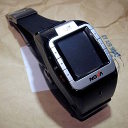
This was my first watch phone, a clone of one of the very first true watch phones, the Hyundai W100. My full review is available elsewhere. It was too bulky to wear under a shirt, and had a tiny screen and simple interface with a few bugs. Although the charging/data cable was identical to the then common mini-USB, the pin-out was proprietary and the phone shut off when attempting to use a standard cable.
It did one thing right however: it was surprisingly convenient to use as a telephone. This was thanks to the ability to quickly detach it from its wristband, something I have sorely missed in my subsequent watch phones. It also had quite good battery life. I don't know if it was due to its unexpected convenience or merely the fact that it was my first watch phone, but the Nova N800 will always keep a special place in my heart. If it weren't for its bulkiness, I would have bought its re-styled successor N588.
2009/08: LG GD910 Watch Phone

This has long remained the only watch phone with 3G connectivity. It was ahead in other ways as well: it looked good, showed time continuously (finally a true watch phone), was waterproof, and had quite good battery life. The big minuses were its outrageous price, lack of any internet browser (how ironical on the only watch phone with 3G), and as a telephone it was not very convenient despite its foldable clasp.
2009/08: Samsung S9110 Watch Phone

Released around the same time as the GD910, a slightly less expensive alternative but still quite pricey especially considering the less impressive feature set. No 3G, not even tri-band, no continuous time display, not waterproof, mediocre battery life, and no camera. It did have an elegant design and was one of the thinnest watch phones at that time.
2010/09: Burg watch phone
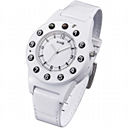
A Dutch company brought a new kind of watch phone to the market, a model that obviously put a lot of emphasis on the watch aspect. From a cursory glance it was not obvious that this is a watch phone, because it had a real analog quartz movement. Giveaways were its sheer bulkiness and twelve buttons on the bezel acting as dial buttons. Given that this phone had no display, it read incoming numbers aloud and texting was impossible. It lacked Bluetooth, so next to talking to your wrist the only option was a wired headset. Still, it was a very original design that paid attention to the often overlooked watch aspect. Although I never had any hands-on experience with these devices, they give an impression of better quality control than the average Chinese watch phone. Later on, Burg introduced new models that swapped the analog movement for a digital display, as well as models similar to Chinese watch phones.
2010/09: Chinese ‘Fashion’ S9110
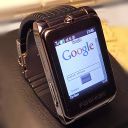
My second watch phone, obviously inspired by the Samsung model bearing the same name. Of course I did an extensive review. Compared to the Nova N800, it had a larger screen (largest among all watch phones except the Z1) and it was flat enough to wear under a shirt, albeit barely due to the overall large size. Again, a proprietary charging/data cable. In other aspects it was a step backwards: poor sound quality, shorter battery life (worse: batteries wore out quickly), the screen was difficult to read in bright light, brightness could not be adjusted. The on-screen keyboard consisted of black letters on a dark grey background, barely readable. The phone was not detachable and had a difficult to open stiff leather band. Even after fitting a folding clasp, all the other issues plus weak microphone sensitivity made me reach for a Bluetooth headset whenever possible.
As a wearable internet device however, the S9110 started to approach what I consider ideal. It allowed to view webpages quite quickly despite the primitive browser and GPRS. The ‘large’ touch screen made browsing surprisingly feasible. This made the device like a wristwatch that did not only show time, but also weather forecasts complete with radar and satellite images, news headlines, and online status of friends. While in a traffic jam, I could check traffic info relatively easy without even having to take my hands off the steering wheel. This really gave me a taste of what may be possible with a properly designed watch phone with better interface and faster data connection.
2011/05: W818
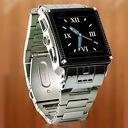
At the time I discovered this model, it was easily the best-looking watch phone I had seen. Some other pluses are true waterproofness, stainless steel band with quick-release clasp, and Java support. It also appears to use microUSB. The problem is that as part of waterproofing, the USB port can only be accessed by unscrewing two screws, which is why the phone is sold with a screwdriver key ring. Given that it will need to be charged every few days, one would be unscrewing and screwing a lot. That is a pretty poor design decision. Also baffling is the primitive screen resolution of only 128×128 pixels. The number of Java apps that will work on this will be limited, and reading text messages or webpages will be awkward. A variation on this model named ‘V5’ looks like a smaller version of the S9110.
2011/10: TW810
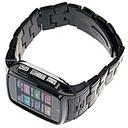
A close contender for being the best-looking watch phone although I still prefer the looks of the W818. Like the latter, the TW810 also has Java and standard micro-USB. What it introduced however was an awesome screen, the same display as the iPod Nano 6th generation. The 1.6" screen has a resolution of 240×240 and is still readable in bright daylight. The TW810 also introduced a slightly revamped interface that is easier to use without a stylus, although still based on the same old MTK platform.
This is one of the greatest examples of the law of conservation of suckiness. I tried out two TW810s from different sellers. Though similar at first sight, they were built in radically different ways. On the first model the awesomeness of the screen was offset by awful text input. It only offered a clunky simulation of primitive multi-tap and handwriting. The second model did have a well-working iPhone-style full keyboard (no handwriting though). I thought: this could be it, the best watch phone yet!
No. Suckiness had to be kept constant, hence whatever idiot designed the firmware completely broke internet connectivity. Manual GPRS configuration was replaced with something ‘automatic’ that never works. You see: for every great thing they add, they destroy another. Why!?
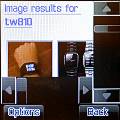
Both models had additional common nuisances: ridiculously thick scroll bars wasting a lot of screen real estate. As the screenshot shows, the built-in web browser is almost useless this way. It baffles me how the designers did not drop the bars or reduce them to thin indicators, and allow swiping like in Opera Mini. Even if there is a patent on that, it is not like China would care. Maybe I should patent ridiculously thick scroll bars and charge any idiot who wants to use them a billion dollars.
The front-facing camera makes it awkward to take photos of anything else than your own face. What is the point of a phone that aspires to offer video calls if it only has GPRS? Of course the camera was still the same 640x480 as on pretty much every Chinese watch phone. One of the two TW810s interpolated to a fake 1.3MPixel.
The bottom line: I wasted precious time and money on two phones that could have been great but proved useless thanks to bugs and the endless Chinese dance of adding and removing features. The result was a serious dent in my patience. These are the kind of experiences that make people consider paying “Apple tax” for an iPhone. Apple at least knows how to make a good interface, and they actually have Quality Control. And behold, they even have support! If these frustrating watch phones are a taste of Chinese technological prowess, then the Western world has little to fear from competition anytime soon. I hope some of you Chinese read this and learn from it. Hint: you could at least upgrade the damn old 16MiB MTK firmware to 32MiB. That would get you a lot farther and not require feature and language pack juggling.
My third watch phone was a variation on the TW810, called the MQ668. It had just not too many bugs to send it back. Instead, I wasted a lot of my sweet time fixing deal-breaking bugs: check out the review. It still left a sour taste after this: it does not even have a stopwatch or calculator. It is plain ridiculous not to have functions a 1980's digital watch had, on a device with a million times the computing power.
2012/01: Z1 Android Watch Phone

For many years this was the only true watch phone that runs Android. It is slow and only an ancient 2.2 version, but still much more flexible than the closed MTK Nucleus system from all other Chinese watch phones. Reviews claim this phone has a pretty good and large screen, and one of the best loudspeakers and microphones among all watch phones. It has GPS, Wi-Fi, and is the only watch phone with EDGE (sad that this sounds like a feat, isn't it?) Its most obvious drawback is the sheer size: it is a massive brick, forget about wearing this under a shirt. No 3G connectivity. Also, the touch screen is somewhat dodgy and sometimes has a mind of its own, as you could read in a review (no longer online, but you can find it in the Internet Archive).
2012/05: Pebble E-Paper Watch
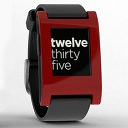
Now this would be a great watch phone, if it had been a watch phone. It looks good, has an e-paper display with backlight (I didn't even know this was possible), continuous time display, good battery life, and is waterproof. Minuses are that the screen is small compared to the size of the entire device, it is not a touch screen, and most obviously, the Pebble is not a phone. It is only a Bluetooth device that requires a smartphone to do anything else than acting like a plain watch.
2012/07: I'm Watch
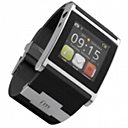
The I'm Watch is another product that is much more polished than the average Chinese watch phone. It is designed by an Italian company and certainly looks great. Pricing is reasonable, about twice the cost of the more expensive Chinese watch phones. Like the Pebble however, the catch is that it is not a stand-alone phone despite the fact that it has a loudspeaker and microphone. It requires a bluetooth connection to an actual phone to make calls. Otherwise, it looks very good and runs Android. Of course, the tiny screen and the ancient 1.6 version it is based on will limit what one can run on it, but it certainly beats the primitive OS that runs on each and every Chinese watch phone.
2013/03: WiMe NanoSmart

Despite failing to raise enough funding on IndieGogo, the Taiwanese company WiMe went ahead manufacturing the NanoSmart anyway. Upsides and downsides:
- Detachable! Comes with both a wristband and a clip.
- Very thin, about 11mm
- 3.5mm headphone jack and micro-USB
- Can work as standalone phone or as companion device to Android phones
- Looks much better designed than the average Chinese watch phone
- No built-in loudspeaker!
- No browser (despite EDGE connectivity)
- The small display only covers about 40% of the available surface
- Low battery capacity
- Primitive MTK operating system
- Not water-resistant
- No camera
This comes damn close to what I am looking for, unfortunately the lack of a loudspeaker and browser are major deal-breakers. You see, the law of conservation of suckiness even exists in Taiwan. I hope WiMe makes a new version of the same size, yet with a bigger screen, a loudspeaker, and a browser (and why not, Android).
2013/09: Samsung Galaxy Gear

Samsung announced the successor to their unsuccessful S9110, called the Galaxy Gear. One wonders whether they actually bothered to figure out why their and other companies' previous wearable products failed, because this one looks designed to flop from the get go. There is nothing that really sets it apart from the other offerings. It is again nothing but a smartwatch that needs a phone nearby to be of any use. It is rather bulky and not detachable (not that it matters because it is not a phone). Style-wise it looks decent, except for the hideous HAL9000-style eye on the wristband. “Open a phone call, HAL.” – “I'm afraid I can't do that, Dave. I'm just a wireless display for your real phone.”
Update 2013/12/06: one in three customers return their Galaxy Gear. Samsung believes this is due to limited compatibility. They still do not get the point.
2013/12: Neptune Pine
The Neptune Pine went through a very successful KickStarter campaign and it does meet many of my requirements including the all-important detachability. There are only a few points where it fails. The ones I could live with because they are inherent technological limitations, are the lack of permanent time display, border-free screen, and long battery life. The deal-breaker however is the size. The Pine is huge, too large to wear as a day-to-day watch. I hope it is successful enough to show there really is a market for watch phones, and to motivate Neptune to produce other (smaller!) models. At this time they seem to be the only company that understands what a watch phone truly is about.
2013/09: Omate TrueSmart / Pearl Simvalley AW-414.go
These are two other upcoming true watch phones that run Android. They are based on the same hardware platform, only the housing and some of the specifications are different. You can already order them if you know where to look. Upsides and downsides:
- Not enormously large (although still quite thick for a watch)
- Adequate to good water-resistance
- They run a very recent Android version
- Not detachable and has a tang buckle strap. Boo!
- No continuous time display
- Still a rather large border around the display. From prototype photos I computed that the display covers only about 55% of the total surface.
- Mediocre battery life.
By the way, I keep reading ‘Omate’ as ‘Ornate’ — a bit of Googling shows I am not alone in this. Anyhow, even though these models still are not what I expect from a watch phone, they are definitely a leap in the right direction and a good sign that the reign of underwhelming Chinese watch phones is about to end. Really nice is that the TrueSmart platform can be licensed and incorporated in other designs. Obviously, I am waiting for someone to put this hardware in a detachable design. The Neptune Pine scores better on the kind of features I want, but it is plain too big. The TrueSmart is a better compromise between wearability, price, and features.
2013/10: ZGPAX S5, IKWear IK8, …
The S5 is another watch phone based on a platform similar to the Omate and Pearl, only this is a 100% Chinese product. It is pretty decent though, and offers quite a punch for its small size. It is also less than half the price, so I could not resist buying one to try it out. My experiences were rather positive although it does have some major bugs, and still is nowhere near my ideal watch phone. I also tested the IKWear IK8 which is based on almost identical hardware, but scores a lot better on the quality front. These models give me the impression that the Chinese are steadily gaining know-how.
2014/??: Google smartwatch?
There are indications that Google has bought a smartwatch company called WIMM, which obviously means they want to release a Nexus smartwatch in the near future. The author of the same article seems to find it obvious that it will again only be a companion device to a smartphone, but again: I have a firm belief that such devices will not be able to spawn a booming market. If Google wants to do something interesting, they should make the device more than yet another tiny wireless display for a bulky smartphone.
2014/??: HeadWatch
The HeadWatch is (or was, the headwatch.com website is now dead) another interesting concept: not only is it detachable, but it can be hooked onto the user's ear as an earpiece. This actually makes a lot of sense because a watch-like device should remain small and light anyway, so wearing it on one's ear is not as crazy as some narrow-minded journalists tend to believe. Of course, its major drawback is that it is yet another slave device that needs a bulky smartphone in the immediate vicinity, which reduces its usefulness to that of merely a very fancy bluetooth earpiece.
2013/03: Apple ‘iWatch’ Rumours
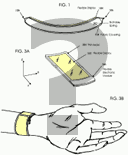
There have been some rumours about Apple working on a ‘smartwatch’, sparked by yet another vague patent application. The whole idea would be that Apple would yet again pioneer a new market as they did with the iPod, iPhone, and iPad. As a matter of fact, what they did in all those cases was kickstart a market that already existed but had not yet managed to catch on. For instance, MP3 players existed long before the iPod but they all lacked in some way, making them unappealing to the general public. Theoretically, it could be the same for ‘smartwatches’.
The patent images show something that appears to still belong in the realm of science-fiction: one large flexible screen that could snap around the wrist like a bracelet. This is a good solution for detachability, add a speaker and microphone and it could meet all my demands. I do not see it happening in the near future however. Even though prototypes of the required technology may exist, they are far from being mass-produced, and the battery will again be the largest deal-breaker.
2015/04: Apple Watch
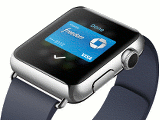
Two years after the rumours, the final product has finally shown its face. Of course, it does not look anything like the rumours, instead it is entirely predictable:
- Only a companion device, intended to make naïve people buy two devices instead of just one, until they realise after a few months that this only complicates their life instead of simplifying it.
- A nice design as expected from Apple, with an emphasis on fashion.
- A nice interface, but dumbed down to appeal to a public as large as possible. The only ways to respond to texts is either with canned responses (which sucks), or dictation. Yeah, now everyone around you can hear what you are texting, especially because you will be repeating the same thing over and over again due to the fact that speech-to-text still sucks for anything that is not trivially simple.
- Some custom gizmos like real-time sketch sharing that people will use for the first 15 minutes, and then forget.
- Locked entirely into the Apple ecosystem, especially the new Apple Pay feature. The Pay idea is nice, but it being completely proprietary is not nice at all and will severely hamper world-wide adoption.
- A worrying lack of any mention of battery life before the product was released. Sure enough, after it was released, reviews confirm a very poor autonomy. Reviews also state how poor a watch this actually is!
In short, although it may be a technological marvel, I don't care for it. It is disappointing how Apple is mostly following the same trend that has already been started by Samsung and LG, with the only innovation being entirely geared to locking consumers into the Apple ecosystem. I guess mankind needs to go through this phase of companies trying to scrape a little extra profit from mostly useless companion devices, before people realise that standalone devices make much more sense, especially in the current world of cloud-based services. Requiring devices to be tethered to each other within a limited distance of a dozen meters is only a small step up from them being connected by a physical cable. Tethering belongs in the twentieth century, not the twenty-first.
2014/06: ‘Abardeen’ F80
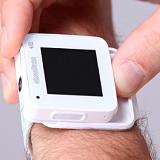
Finally we are getting somewhere. This is a very recent model, it is difficult to find at the moment. A near-identical model can be found under the name ‘AbarGoo’ (although it is unclear whether that one is being sold at all). I could not resist getting one to try out, and now that I have it, I am pretty pleased. Why? The photo says it all: detachable. This model is very similar to the Neptune Pine and is marketed with similar ‘active lifestyle’ branding, but it is much more reasonably sized than the Pine (about 47×47×14mm). It runs Android 4.2, has a sideways-pointing camera of exceptional quality, hardware volume buttons, a headphone jack, and there are accessories like a windshield mount and bicycle handlebar mount. It is the best match for my wish list so far and in my opinion, one of the most usable watch phones currently available. Installing a custom ROM is mandatory to make it truly usable though. Check out my review of the F80.
Conclusion
The main reason why I wrote this article is that I hope mobile device manufacturers will read it, agree with the features I consider essential in a watch phone, and obviously, manufacture such a device. As it is now, none of the models currently available cut the cake. Some come close, some previous models have come close, but there is not a single one that does not have a major deal-breaking problem.
This also translates into advice for people who just want to know what is the current state of watch phones and smartwatches, and whether it is worthwhile to buy one at this point. My answer is: not really. If you badly want one, you might consider the Pine, TrueSmart, or F80, but if you are patient enough I would wait a little longer until there is a perfect combination of those three models: detachable like the Pine/F80 and with all the features, but small and elegant like the TrueSmart.
Go to the blog post that announces this article if you would like to comment.
Roulette photo by Ralf Roletschek under Creative Commons Attribution-Share Alike License